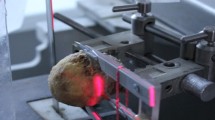Abstract
Chemical sterilisation methods for musculoskeletal transplants have the problem of penetration into all tissue strata. The present study examined if a peracetic acid/ethanol solution penetrated to a sufficient extent into specifically prepared femoral heads. To this effect, 10 femoral heads have been provided with drillings (diameter 2 mm, depth 10 mm) at a distance of 15 mm (series B) and placed in a diffusion chamber with sterilisation solution. From an additional central drilling at the femoral neck junction, the sample drawing was made after 30 min each over a period of 4 h for the iodometric determination of peracetic acid (PAA) concentration. Ten femoral heads, which did contain only the central drilling, served as controls (series A). In 9 of the examined femoral heads of series A the defined minimum concentration of PAA of 0.2% (inactivation of bacteria, spores, fungi) has been clearly exceeded over the complete period of measurement. About 0.8% PAA (inactivation of viruses) was achieved within 4 h only with six femoral heads. Nine out of the 10 examined femoral heads in series B show a clearly improved penetration behaviour which was expressed in smaller standard deviations, a faster increase in concentration, as well as in higher starting and final concentrations (approx. 0.9%) of PAA. Previous drying in air leads to a faster penetration into the centre of the bone. Standardised drilling of decartilaged femoral heads creates favourable conditions for the penetration of the PAA sterilisation solution into the whole tissue and guarantees a sufficient inactivation of microorganisms.
Similar content being viewed by others
References
R. Böhm H. Stockinger (1985) ArticleTitleErgebnisse der experimentellen Desinfektionsmittelprüfung an Sporen verschiedener Clostridienarten mit Formaldehyd und Peressigsäure [Results of the experimental disinfectant test on the spores of various clostridium types with formaldehyde and peracetic acid] Hyg. Med. 10 44–48
K. Botzenhardt R. Jaax (1985) ArticleTitleBestimmung der Abtötungskinetik von Bacillus-Sporen durch Peressigsäure. [Determination of the destruction kinetics of bacillus spores by peracetic acid] Zentralbl Bakteriol Mikrobiolog Hyg. 181 139–50
InstitutionalAuthorNameCDC, Center for Disease Control and Prevention (2002) ArticleTitleUpdate: allograft-associated bacterial infections MMWR 51 IssueID10 207–210
InstitutionalAuthorNameDeutsche Gesellschaft für Hygiene und Mikrobiologie (2003) Desinfektionsmittel-Liste der DGHM. [List of disinfactants of the German Association of Hygiene and Microbiology (DGHM)] mph-Verlag Wiesbaden
T. Eastlund D.M. Strong (2003) Infectious Disease Transmission through Tissue Transplantation G.O. Phillips (Eds) Tissue Banking, vol. 7 World Scientific SingaporeLondon 51–132
InstitutionalAuthorNameEuropäisches Arzneibuch [European Pharmacopoeia] - Ph. Eur. 4.00 (2004a) Grundwerk 2002 mit Nachtr. 4.1, 4.2, 4.3, 4.4, 4.5, Kapitel 2.5.30, 4. Auflage Deutscher Apotheker Verlag Stuttgart
InstitutionalAuthorNameEuropäisches Arzneibuch [European Pharmacopoeia] – Ph. Eur. 4.00 (2004b) Grundwerk 2002 mit Nachtr. 4.1, 4.2, 4.3, 4.4, 4.5, Kapitel 2.2.32, 4. Auflage Deutscher Apotheker Verlag Stuttgart
European Association of Tissue Banks and European Association of Musculo-Skeletal Transplantation 1999.EATB and EAMST Common Standards for Musculo Skeletal Tissue Banking, Vienna.
R.J. Lomas O. Drummond J.N. Kearney (2000) ArticleTitleProcessing of whole femoral head allografts: a method for improving clinical efficacy and safety Cell Tissue Banking 1 IssueID3 193–200 Occurrence Handle10.1023/A:1026512312385
R.J. Lomas Q. Huang D.E. Pegg J.N. Kearney (2004a) ArticleTitleApplication of a high-level peracetic acid disinfection protocol to re-process antibiotic disinfected skin allografts Cell Tissue Banking 5 IssueID1 23–36 Occurrence Handle10.1023/B:CATB.0000022236.14311.b9
Lomas R.J., Jennings L.M., Fisher J. and Kearney J.N. 2004b. Effects of a peracetic acid disinfection protocol on the biocompatibility and biomechanical properties of human patellar tendon allografts. Cell Tissue Banking 5(3): 149–160.
A. Pruss B. Baumann M. Seibold M. Kao K. Tintelnot R. Versen Particlevon H. Radtke T. Dörner G. Pauli U.B. Göbel (2001) ArticleTitleValidation of the sterilisation procedure of allogeneic avital bone transplants using peracetic acid–ethanol Biologicals 29 59–66 Occurrence Handle10.1006/biol.2001.0286 Occurrence Handle11580210
A. Pruss U.B. Göbel G. Pauli M. Kao M. Seibold H.J. Mönig A. Hansen R. von Versen (2003) ArticleTitlePeracetic acid–ethanol treatment of allogeneic avital bone tissue transplants – a reliable sterilisation method Ann. Transplant. 8 IssueID2 34–42 Occurrence Handle14626574
A. Pruss M. Kao H. Kiesewetter R. Versen Particlevon G. Pauli (1999) ArticleTitleVirus safety of avital bone tissue transplants: evaluation of sterilisation steps of spongiosa cuboids using a peracetic acid–methanol mixture Biologicals 27 195–201 Occurrence Handle10.1006/biol.1999.0177 Occurrence Handle10652175
M. Sprössig H. Mücke (1969) ArticleTitleDie Virusdesinfektion durch Peressigsäure in Gegenwart von Alkoholen [Virus disinfection with peracetic acid in presence of alcohol] Wiss. Z. Humboldt-Univ., Math.-Nat. R 18 1171–1173
R. Starke R. Versen Particlevon (1984) ArticleTitleExperimentelle Untersuchungen zur Entkeimung von Transplantationsmaterial mit Peressigsäure [Experimental investigations of germ inactivation with peracetic acid in tissue transplants] Z. Exp. Chir. Transplant. künstl. Organe 17 IssueID5 254–258
von Versen R., Heider H., Kleemann I. and Starke R. 1992. Chemische Sterilisation Biologischer Implantate Mit Einer Kombinationsmethode [sterilisation of biological implants using a combination method]. In: Pesch H.J., Sto¨ ß H. and Kummer B. (eds), Osteologie Aktuell. 7 (suppl): 380–386.
Wallha¨ usser K.H. 1995. Praxis der Sterilisation, Desinfektion und Konservierung. [Practice of sterilisation, disinfection and preservation], 5th ed. Thieme, Stuttgart.
P. Wutzler A. Sauerbrei (2001) Peressigsäure-Ethanol – Ein potentielles viruzides Händedesinfektionsmittel [Peracetic acid–ethanol – a potential virucidal disinfactant for disinfection of hands] H.F. Rabenau O. Thraenhart H.W. Doerr (Eds) Nosokomiale Virusinfektionen – Erkennung und Bekämpfung Pabst Science Publishers Lengerich 92–100
Author information
Authors and Affiliations
Corresponding author
Rights and permissions
About this article
Cite this article
Brosig, H., Jacker, HJ., Borchert, HH. et al. Sufficient Penetration of Peracetic Acid into Drilled Human Femoral Heads. Cell Tissue Banking 6, 231–237 (2005). https://doi.org/10.1007/s10561-005-1473-0
Received:
Accepted:
Issue Date:
DOI: https://doi.org/10.1007/s10561-005-1473-0




